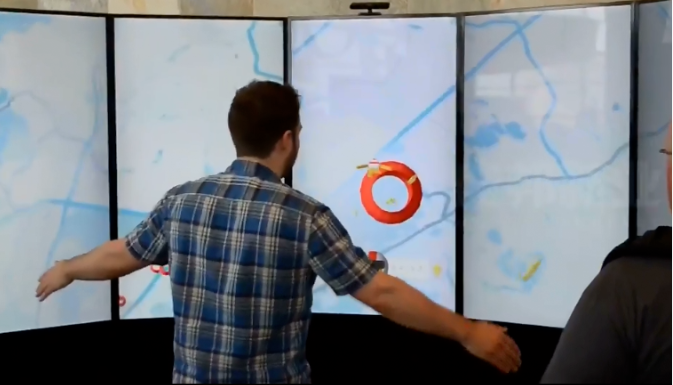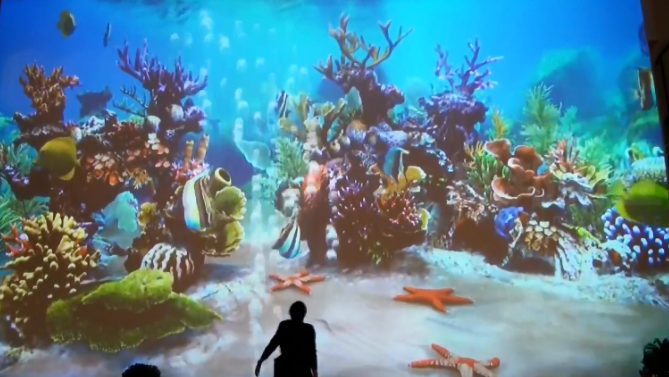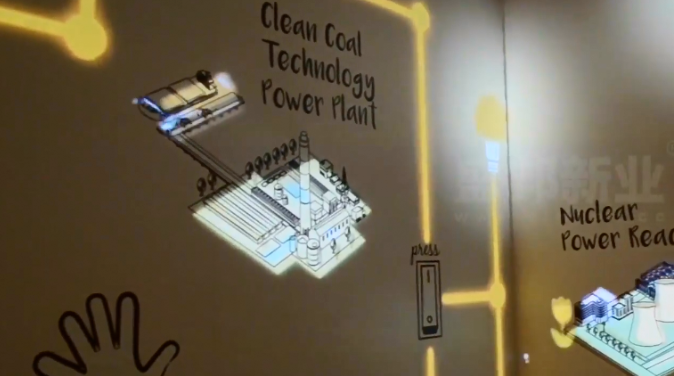The Power of Multimedia Interaction
As digitalization and “E+ connectivity” reshape visitor experiences, multimedia display technology has become the centerpiece of modern exhibition halls.
By combining computer vision, projection mapping, and LiDAR sensing, interactive projection systems turn ordinary surfaces into dynamic storytelling tools that react to human movement, touch, and gestures.
These systems merge art, technology, and emotion, transforming museums, brand showrooms, and educational spaces into immersive environments that capture imagination and attention.
1. Floor Interactive Projection System
Also known as Interactive Floor, Interactive Pond, Footprint Projection, or Lotus Projection, this system uses advanced computer vision and real-time rendering to create stunning effects underfoot.

How It Works
When visitors walk across the projection area, CPJROBOT’s POE LiDAR sensors detect movement and instantly trigger visual effects such as ripples, splashes, collisions, or particle trails.
Key Advantages
- Transforms any floor into a real-time interactive playground
- Fully integrated design for quick setup and easy control
- Supports dynamic content: water waves, floating leaves, glowing footprints, and more
With multi-touch radar sensing and auto calibration, CPJROBOT ensures fluid interaction across large spaces — perfect for museums, commercial exhibitions, and public attractions.
2. Interactive Table Projection System
The Interactive Table System brings digital content to the tabletop, replacing the traditional “mouse + keyboard” interface with multi-touch gesture control.

Features
- Supports simultaneous multi-user operation
- Enables direct manipulation of text, images, videos, and 3D animations
- Encourages collaboration and creative engagement
Just by touching or swiping across the projection surface, visitors can explore digital menus, rotate 3D models, or paint in mid-air.
CPJROBOT POE LiDAR provides smooth gesture tracking and wide-angle coverage, delivering precise interaction without external cameras.
3. Body-Sensing Interactive System

The Body-Sensing Interaction System uses depth sensors and motion capture technology to track visitors’ gestures and movements in real time.
When the viewer waves, jumps, or walks, the projected image responds dynamically — turning motion into animation.
It’s a bridge between the virtual and physical worlds, ideal for interactive games, digital art installations, and educational exhibits.
CPJROBOT Technology Advantage
- LiDAR-based tracking unaffected by lighting or background noise
- Real-time, low-latency motion capture
- Scalable for multiple participants
This technology transforms visitors into active participants — blurring the line between performer and observer.
4. Interactive Wall Projection System

The Interactive Wall System (also called motion wall or gesture wall) creates dynamic visuals on large surfaces that respond to user actions.
How It Works
Advanced projection mapping and LiDAR motion detection generate visual effects such as ripples, flying particles, or floating graphics that follow human movement.
Benefits
- Supports multi-user interaction without interference
- Can be scaled up using multiple projectors for larger displays
- Simple installation with no touch screens or sensors on the wall
With CPJROBOT POE LiDAR, walls become intelligent canvases — precise, immersive, and maintenance-free.
Ideal for corporate showrooms, art museums, retail displays, and science centers.
5. Interactive Drawing System

An Interactive Drawing System combines multiple touch tables with a large digital display wall.
Users can draw on digital surfaces or scan paper sketches, which then come alive on the projection screen — turning imagination into animation.
Key Benefits
- Encourages creativity and engagement, especially for children
- Supports hand-drawn art, scanned images, and digital painting
- Combines learning with entertainment through gamified experiences
The system promotes edutainment (education + entertainment) — helping children explore art, imagination, and interactivity while developing creativity and motor skills.
6. Magic Interactive Wall System (“Hogwarts Wall”)

The Magic Interactive Wall, inspired by fantasy worlds like Hogwarts, creates magical effects through touch-responsive projection.
When children touch the wall, animations and sounds appear — glowing, moving, and fading like a spell.
Experience Highlights
- Combines sound, animation, and motion for sensory engagement
- Encourages curiosity, exploration, and interactive learning
- Perfect for children’s museums, educational zones, and themed entertainment centers
This magical blend of education and play keeps visitors delighted and engaged — bringing storytelling to life through technology.
Why Choose CPJROBOT POE LiDAR for Interactive Projection
CPJROBOT’s POE (Power over Ethernet) LiDAR technology is the foundation of modern interactive projection systems — providing accuracy, simplicity, and scalability.
Core Advantages
- Multi-Touch Radar Interaction: Detects multiple users simultaneously
- Auto Calibration: Adjusts automatically to the environment — no manual setup required
- Wide-Angle Coverage: 270°/360° sensing for large walls and floors
- PoE Power Supply: One cable for power and data, ensuring safe, clean installation
- High Stability: Works perfectly in bright or complex lighting environments
When combined with CPJROBOT Reception & Navigation Robots, exhibition halls gain intelligent interaction — from touch-free wall projections to autonomous visitor guidance.
Applications in Modern Exhibition Halls
- Museums & Science Centers – Interactive learning and immersive education
- Corporate Showrooms – Digital storytelling and brand experiences
- Art Galleries – Creative expression through motion and projection
- Children’s Play Zones – Educational entertainment and gamified learning
- Shopping Malls & Theme Parks – Eye-catching entertainment and crowd engagement
Each system enhances the visitor experience, increasing participation, memorability, and social media sharing value.
Frequently Asked Questions (FAQ)
Q1: What makes CPJROBOT POE LiDAR different from infrared or camera systems?
A: Unlike cameras or infrared sensors, LiDAR uses laser time-of-flight technology, offering centimeter-level precision and stable performance in any lighting condition.
Q2: Can multiple LiDAR sensors be used together?
A: Yes. CPJROBOT supports cascading multiple LiDAR units to cover large or irregular spaces, ensuring seamless tracking across wide areas.
Q3: Is installation complicated?
A: Not at all. The POE design allows single-cable installation for both power and data, and the system automatically calibrates without manual alignment.
Q4: Can CPJROBOT LiDAR integrate with service robots?
A: Absolutely. CPJROBOT’s LiDAR sensors share data with reception and navigation robots, enabling synchronized interaction and intelligent visitor guidance.
Q5: What types of content can be used in interactive projection?
A: From 2D graphics and 3D animation to educational games and branded storytelling — all content can be customized to match the client’s concept.
Conclusion
Interactive projection is revolutionizing multimedia exhibition halls — blending technology, creativity, and emotion into unforgettable experiences.
From interactive floors and tables to magical walls, every system enhances engagement, education, and entertainment.
With CPJROBOT’s POE LiDAR sensors and reception & navigation robots, you can create exhibition spaces that are smarter, immersive, and future-ready — where every gesture tells a story.







